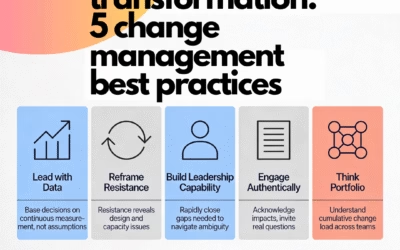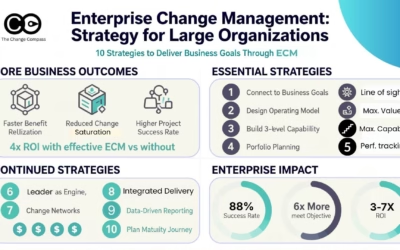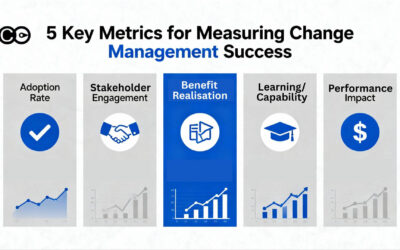As a change management practitioner, your mission is to guide organisations through change, building their ability to manage transitions effectively and sustainably. A major part of this work often involves helping organisations develop their “change maturity” — the capacity to continuously and successfully deliver change. Many experienced change practitioners focus on moving organisations along this maturity curve, seeing it as a vital part of creating a culture that embraces and sustains transformation.
However, in this pursuit, there’s a potential risk: becoming too fixated on achieving “change maturity” can cloud your judgment about what the organisation really needs. You may find yourself caught up in the desire to build structured change processes, educate stakeholders on every change theory, or create complex frameworks to assess and elevate change capability. While these elements are important, an over-reliance on them can impede progress. In some cases, your organisation might be more capable of managing change than you think, but your approach could be holding them back.
There are several common areas where change practitioners may become too focused on change maturity — and how this focus can actually hinder their ability to support successful, meaningful change. We’ll delve into how overemphasising change terminology, processes, structures, and risk-averse approaches can become obstacles to progress. By understanding and addressing these potential pitfalls, you can better align your support with the unique needs and readiness of your organisation, enabling a smoother, more effective path to support successful change.
Are You Too Quick to Label Your Organisation as Change Immature?
One of the first traps experienced change practitioners might fall into is quickly labeling their organisation as “change immature.” It’s tempting to assess an organisation’s change capability through the lens of formal change frameworks and models, but by doing so, you may be discounting their informal ability to adapt to change.
In other words, is your ‘label’ placed on the organisation a potential self-fulfilling prophecy? For example, if you see the organisation as mildly change mature, your approach and lens may all be geared around this label and expectation.
Organisations that have not formally defined their change management processes or have not made concerted efforts to assess their change maturity might seem “immature” on the surface. But that doesn’t mean they lack the inherent capacity to change. In many cases, businesses have evolved and navigated transitions without formal change models in place, relying on their leadership, adaptability, and problem-solving capabilities.
Example: Mislabeling the Organisation’s Maturity
Consider a large, successful organisation with a history of navigating mergers, market shifts, and product innovation. While this company may have never formalised a change management function or assessed its change maturity, its survival and success prove that it has navigated complex changes in the past. You, as the change practitioner, might arrive and see that the business lacks a formal change methodology like Prosci or Kotter, so you label them as immature. As a result, you might start recommending a highly cautious, structured approach to “bring them up to speed.”
However, this label can lead to unnecessary delays. Rather than imposing new structures or over-engineering the process, it could be more effective to build on the organisation’s existing ways of working. The business may already have the right instincts, and simply needs to refine its approach to handle more formalised, larger-scale change efforts.
This cautious approach of assuming immaturity often leads to missed opportunities for progress. It slows down the pace of change and leaves businesses feeling that they are incapable of handling large-scale change without significant external help.

Change Terminology and Concepts: Over-Education vs. Practical Implementation
Another common pitfall is becoming too focused on educating stakeholders about change management concepts and frameworks, rather than focusing on practical implementation. It’s easy for experienced change practitioners to get caught up in explaining the intricacies of change theories, but the reality is that many stakeholders may not need or want this level of detail.
Stakeholders, especially those in senior leadership positions, are often more interested in results than in the underlying change management theories. Spending too much time educating them on ADKAR, Kotter’s 8-step process, or Lewin’s model can divert attention from the critical issue: how to implement the change in their specific organisational context.
Using and coaching your stakeholders on implementing change without change methodology is a skill, but one that can be critical.
Example: Change Concepts vs. Actionable Strategies
Imagine working on a digital transformation project where the leadership team is eager to see results. Instead of diving straight into how the change will be implemented, you spend the first few weeks educating the leaders on the theory behind change management, explaining why each stage of the ADKAR model is important and why a structured approach is necessary. While these concepts are valuable, the leadership team is left feeling overwhelmed by jargon and disconnected from the practicalities of the change they need to deliver.
A more effective approach in this situation might be to focus on practical, actionable strategies that are action-based learning. Instead of over-explaining change concepts, walk stakeholders through the steps they need to take, provide them with tools to manage resistance, and give them clear, real-time metrics on progress. In many cases, stakeholders don’t need an in-depth lesson on change theory—they need guidance on how to lead change within their teams, how to prepare and engage effectively, and how to overcome resistance.
Even if you don’t focus on education, and instead label them as change immature. This in itself can be dangerous and unhelpful. As a result you don’t implement the right approaches to support the change required to achieve their business goals.
While it’s essential to help stakeholders understand the principles behind change, overemphasis on theoretical knowledge can take the focus away from delivering the change itself.
Processes and Structures: Building New or Leveraging Existing?
One of the hallmarks of a maturing change organisation is the establishment of formal structures and processes to support change. Communities of practice, change champion networks, formalised governance bodies, and change management offices all play vital roles in building long-term change capability. However, there’s a risk of becoming too focused on building these structures rather than finding ways to work within the current framework of the organisation.
When faced with the task of improving change capability, many practitioners instinctively begin to build new structures from scratch. However, this can add complexity and create parallel processes that the business may not be equipped to handle. Sometimes, rather than introducing new structures, the better approach is to refine and optimise existing business processes and forums to embed change more naturally.
Example: Building New Structures vs. Leveraging Existing Ones
Consider an organisation that already has strong cross-functional governance in place for operational projects. Instead of introducing a new change champion network, you could work with the existing project governance structures to ensure change management principles are integrated into these meetings. By adapting existing forums to include change discussions, you avoid creating extra layers of complexity and leverage routines that are already familiar to the business.
The challenge is to balance the need for formal change structures with the desire to minimise disruption to current workflows. Often, the most effective approach is to enhance existing structures rather than building entirely new ones. This also helps to prevent the perception that change management is an “additional burden” rather than an integrated part of business operations.
‘Babying’ Your Stakeholders: Are You Doing the Change for Them?
As a change practitioner, it’s natural to want to help stakeholders navigate the complexities of change. But there’s a fine line between supporting your stakeholders and doing the change for them. When you step in to handle every aspect of the change process, you risk undermining your stakeholders’ ability to build their own change capability.
The goal of change management is to empower the business to manage change independently. If you are too involved in managing the change, you can inadvertently create dependency, where stakeholders rely on you to handle resistance, communications, or decision-making. This not only stifles their growth but also prevents the organisation from building a sustainable, internal capacity for change.
Example: Over-Involvement vs. Coaching for Capability Building
Suppose you’re leading a change initiative in a large organisation, and you find yourself handling most of the communications, solving problems that arise, and managing resistance from teams. While you may feel that you’re helping, the reality is that your stakeholders are becoming overly dependent on you to manage the change.
A more effective approach is to take a coaching stance. Rather than doing the change for them, help your stakeholders learn how to anticipate resistance, communicate effectively, and manage change within their teams. Offer guidance and support, but resist the temptation to take over. When you empower stakeholders to lead the change themselves, you help them build the confidence and skills they need to manage future changes more independently.
The key is to recognise when your involvement is crossing the line from support into doing the change for them. The more you can coach and mentor your stakeholders, the more resilient and capable the organisation will become.

Setting the Bar Too Low for Your Organisation
The COVID-19 pandemic demonstrated something profound about people and organisations: they are capable of changing far more quickly than we might have thought. Practically overnight, organisations adapted to remote working, adopted new technologies, and restructured their operations. This rapid adaptation showed that many organisations have far more resilience and capacity for change than we often give them credit for.
But in the post-pandemic world, are you still setting the bar too low for your organisation? Are you approaching change cautiously because you assume the business is not capable of rapid adaptation? If so, you may be underestimating their ability to handle larger-scale change or more ambitious transformation initiatives.
Example: Underestimating Organisational Capacity
Imagine working with an organisation that wants to implement a large-scale digital transformation. You might assume that because the business has not undertaken such a significant change before, they will need to move cautiously, taking small steps toward change maturity. However, given the right leadership support, clear communication, and resources, the organisation might be able to implement the transformation far more quickly and effectively than anticipated.
The key is to challenge your assumptions about the organisation’s capacity for change. Instead of setting the bar too low and taking overly cautious steps, consider where you can stretch the organisation’s potential. Businesses often have far more adaptability and resilience than we might assume, and by aiming higher, you can help them achieve more ambitious outcomes. Again, COVID was a clear demonstration of what can be possible.
Caution vs. Progress: Finding the Right Balance
One of the biggest challenges for change practitioners is finding the right balance between caution and progress. In many cases, particularly with organisations that are newer to structured change management, a cautious approach may feel like the safest route. But taking overly cautious steps can prevent the organisation from achieving the level of change it needs to succeed.
The other side of the equation is pushing too hard, too fast. While organisations may have a greater capacity for change than we give them credit for, they also need time to adapt and build their change capability. The trick is to strike the right balance between ambitious progress and thoughtful pacing, especially iterative paced learning.
Example: Caution vs. Ambition in Portfolio-Level Change
Consider an organisation that is managing a portfolio of change initiatives. One approach is to take small, incremental steps to build change capability, slowly rolling out new processes and frameworks. While this approach may feel safe, it can prevent the business from keeping up with the volume and pace of change it needs to manage.
A more ambitious approach might involve embedding change management principles directly into business planning, governance, and decision-making. By integrating change management into existing processes, the organisation can manage a high volume of change more effectively without creating new silos or delays. This approach pushes the organisation to operate at a higher level, while still allowing time for adaptation and learning.
Adjusting Your Lens on Change Maturity
While change maturity is an important goal for any organisation, becoming too fixated on achieving it can inadvertently cloud your judgment and therefore negatively impact outcomes. Overemphasising change models, frameworks, and cautious steps can slow down the pace of change and underestimate the organisation’s capacity to evolve. As a change management practitioner, your role is not just to assess change maturity but to empower the organisation to grow and adapt.
By adjusting your lens and focusing on the organisation’s immediate needs and strengths, you can support more effective, sustainable change. This means balancing formal change processes with practical implementation, empowering stakeholders to lead the change themselves, and setting higher expectations for what the organisation can achieve.
The goal is not just to build change maturity, but to help the organisation experience navigating change in a way gives them confidence and meets their business goals.






